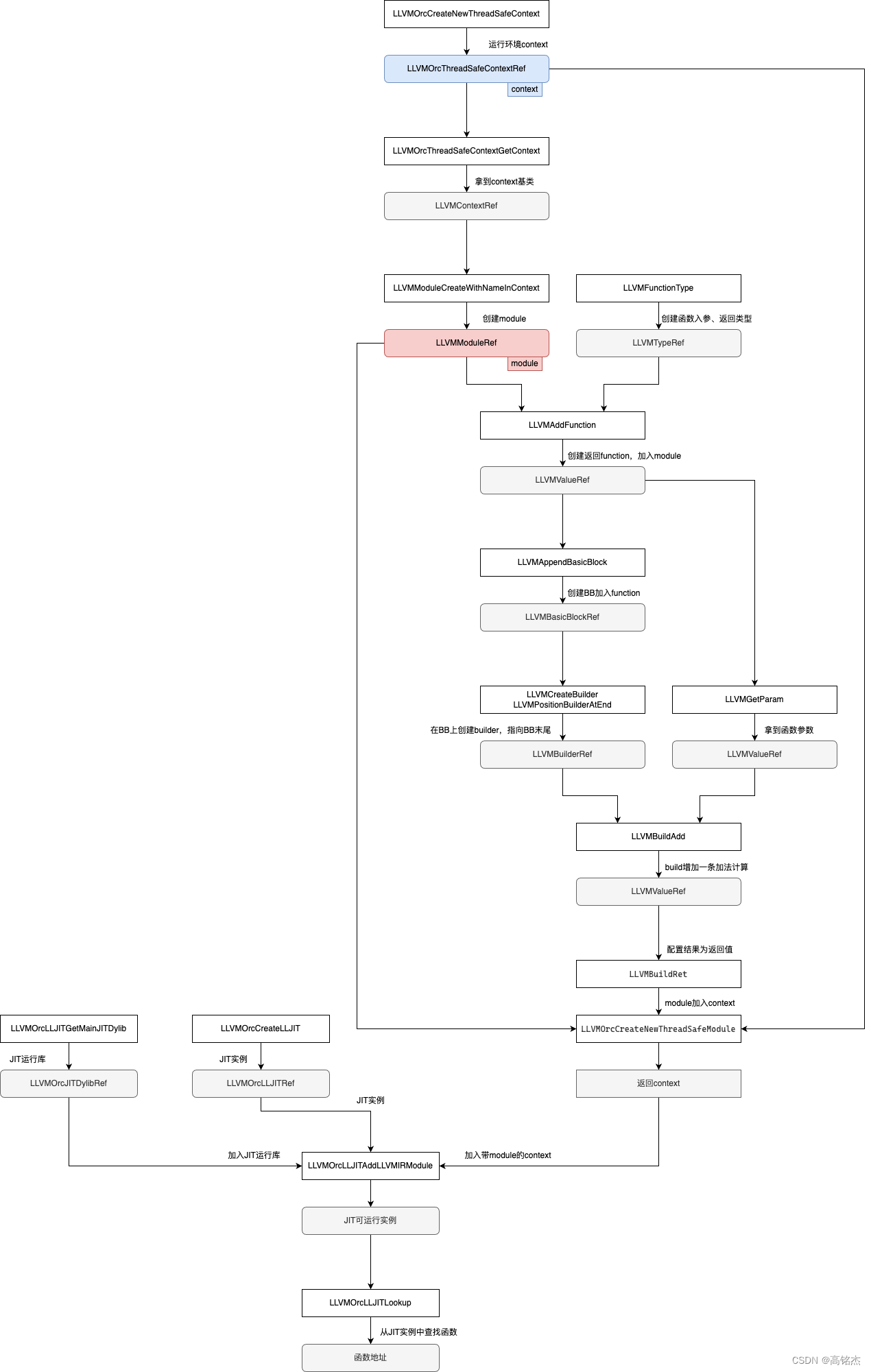本文主要是介绍LLVM(5)ORC实例分析,希望对大家解决编程问题提供一定的参考价值,需要的开发者们随着小编来一起学习吧!
ORC实例总结
总结
- 因为API茫茫多,逻辑上的一些概念需要搞清,编码时会容易很多。
- JIT的运行实体使用LLVMOrcCreateLLJIT可以创建出来,逻辑上的JIT实例。
- JIT实例需要加入运行库(依赖库)和用户定义的context(运行内容)才能运行,LLVMOrcLLJITAddLLVMIRModule函数负责将运行库和ctx加入JIT实例。
- context相当于给用户自定义代码的上下文,其中可以加入多个module,每个module中又可以加入多个function。可以理解为一个工程(context)里面加入多个文件,每个文件(module)中又包含多个函数(function)。

注释
LLVMOrcThreadSafeModuleRef createDemoModule(void) {
// 创建一个新的ThreadSafeContext和底层的LLVMContext。
LLVMOrcThreadSafeContextRef TSCtx = LLVMOrcCreateNewThreadSafeContext();// 获取底层的LLVMContext的引用。
LLVMContextRef Ctx = LLVMOrcThreadSafeContextGetContext(TSCtx);// 创建一个新的LLVM模块。
LLVMModuleRef M = LLVMModuleCreateWithNameInContext("demo", Ctx);// 添加一个名为"sum"的函数:
// - 创建函数类型和函数实例。
LLVMTypeRef ParamTypes[] = {LLVMInt32Type(), LLVMInt32Type()};
LLVMTypeRef SumFunctionType =
LLVMFunctionType(LLVMInt32Type(), ParamTypes, 2, 0);
LLVMValueRef SumFunction = LLVMAddFunction(M, "sum", SumFunctionType);// - 向函数添加一个基本块。
LLVMBasicBlockRef EntryBB = LLVMAppendBasicBlock(SumFunction, "entry");// - 创建一个IR构建器并将其定位到基本块的末尾。
LLVMBuilderRef Builder = LLVMCreateBuilder();
LLVMPositionBuilderAtEnd(Builder, EntryBB);// - 获取两个函数参数,并使用它们构造一个"add"指令。
LLVMValueRef SumArg0 = LLVMGetParam(SumFunction, 0);
LLVMValueRef SumArg1 = LLVMGetParam(SumFunction, 1);
LLVMValueRef Result = LLVMBuildAdd(Builder, SumArg0, SumArg1, "result");// - 构建返回指令。
LLVMBuildRet(Builder, Result);// 演示模块现在已经完成。将其和ThreadSafeContext封装到ThreadSafeModule中。
LLVMOrcThreadSafeModuleRef TSM = LLVMOrcCreateNewThreadSafeModule(M, TSCtx);// 释放本地的ThreadSafeContext值。底层的LLVMContext将由ThreadSafeModule TSM保持活动状态。
LLVMOrcDisposeThreadSafeContext(TSCtx);// 返回结果。
return TSM;
}int main(int argc, char *argv[]) {
int MainResult = 0;// 解析命令行参数并初始化LLVM Core。
LLVMParseCommandLineOptions(argc, (const char **)argv, "");
LLVMInitializeCore(LLVMGetGlobalPassRegistry());// 初始化本地目标代码生成和汇编打印器。
LLVMInitializeNativeTarget();
LLVMInitializeNativeAsmPrinter();// 创建LLJIT实例。
LLVMOrcLLJITRef J;
{
LLVMErrorRef Err;
if ((Err = LLVMOrcCreateLLJIT(&J, 0))) {
MainResult = handleError(Err);
goto llvm_shutdown;
}
}// 创建演示模块。
LLVMOrcThreadSafeModuleRef TSM = createDemoModule();// 将演示模块添加到JIT中。
{
LLVMOrcJITDylibRef MainJD = LLVMOrcLLJITGetMainJITDylib(J);
LLVMErrorRef Err;
if ((Err = LLVMOrcLLJITAddLLVMIRModule(J, MainJD, TSM))) {
// 如果添加ThreadSafeModule失败,我们需要自己清理它。
// 如果添加成功,JIT将管理内存。
LLVMOrcDisposeThreadSafeModule(TSM);
MainResult = handleError(Err);
goto jit_cleanup;
}
}// 查找演示入口点的地址。
LLVMOrcJITTargetAddress SumAddr;
{
LLVMErrorRef Err;
if ((Err = LLVMOrcLLJITLookup(J, &SumAddr, "sum"))) {
MainResult = handleError(Err);
goto jit_cleanup;
}
}// 如果程序执行到这里,说明一切顺利。执行JIT生成的代码。
int32_t (Sum)(int32_t, int32_t) = (int32_t()(int32_t, int32_t))SumAddr;
int32_t Result = Sum(1, 2);// 打印结果。
printf("1 + 2 = %i\n", Result);jit_cleanup:
// 销毁JIT实例。这将清理JIT所拥有的任何内存。
// 这个操作是非平凡的(例如,可能需要JIT静态析构函数),也可能失败。
// 如果失败,我们希望将错误输出到stderr,但不要覆盖任何现有的返回值。
{
LLVMErrorRef Err;
if ((Err = LLVMOrcDisposeLLJIT(J))) {
int NewFailureResult = handleError(Err);
if (MainResult == 0) MainResult = NewFailureResult;
}
}llvm_shutdown:
// 关闭LLVM。
LLVMShutdown();return MainResult;
}
ORC完整
//===------ OrcV2CBindingsBasicUsage.c - Basic OrcV2 C Bindings Demo ------===//
//
// Part of the LLVM Project, under the Apache License v2.0 with LLVM Exceptions.
// See https://llvm.org/LICENSE.txt for license information.
// SPDX-License-Identifier: Apache-2.0 WITH LLVM-exception
//
//===----------------------------------------------------------------------===//#include <stdio.h>#include "llvm-c/Core.h"
#include "llvm-c/Error.h"
#include "llvm-c/Initialization.h"
#include "llvm-c/LLJIT.h"
#include "llvm-c/Support.h"
#include "llvm-c/Target.h"int handleError(LLVMErrorRef Err) {char *ErrMsg = LLVMGetErrorMessage(Err);fprintf(stderr, "Error: %s\n", ErrMsg);LLVMDisposeErrorMessage(ErrMsg);return 1;
}LLVMOrcThreadSafeModuleRef createDemoModule(void) {// Create a new ThreadSafeContext and underlying LLVMContext.LLVMOrcThreadSafeContextRef TSCtx = LLVMOrcCreateNewThreadSafeContext();// Get a reference to the underlying LLVMContext.LLVMContextRef Ctx = LLVMOrcThreadSafeContextGetContext(TSCtx);// Create a new LLVM module.LLVMModuleRef M = LLVMModuleCreateWithNameInContext("demo", Ctx);// Add a "sum" function":// - Create the function type and function instance.LLVMTypeRef ParamTypes[] = {LLVMInt32Type(), LLVMInt32Type()};LLVMTypeRef SumFunctionType =LLVMFunctionType(LLVMInt32Type(), ParamTypes, 2, 0);LLVMValueRef SumFunction = LLVMAddFunction(M, "sum", SumFunctionType);// - Add a basic block to the function.LLVMBasicBlockRef EntryBB = LLVMAppendBasicBlock(SumFunction, "entry");// - Add an IR builder and point it at the end of the basic block.LLVMBuilderRef Builder = LLVMCreateBuilder();LLVMPositionBuilderAtEnd(Builder, EntryBB);// - Get the two function arguments and use them co construct an "add"// instruction.LLVMValueRef SumArg0 = LLVMGetParam(SumFunction, 0);LLVMValueRef SumArg1 = LLVMGetParam(SumFunction, 1);LLVMValueRef Result = LLVMBuildAdd(Builder, SumArg0, SumArg1, "result");// - Build the return instruction.LLVMBuildRet(Builder, Result);// Our demo module is now complete. Wrap it and our ThreadSafeContext in a// ThreadSafeModule.LLVMOrcThreadSafeModuleRef TSM = LLVMOrcCreateNewThreadSafeModule(M, TSCtx);// Dispose of our local ThreadSafeContext value. The underlying LLVMContext// will be kept alive by our ThreadSafeModule, TSM.LLVMOrcDisposeThreadSafeContext(TSCtx);// Return the result.return TSM;
}int main(int argc, char *argv[]) {int MainResult = 0;// Parse command line arguments and initialize LLVM Core.LLVMParseCommandLineOptions(argc, (const char **)argv, "");LLVMInitializeCore(LLVMGetGlobalPassRegistry());// Initialize native target codegen and asm printer.LLVMInitializeNativeTarget();LLVMInitializeNativeAsmPrinter();// Create the JIT instance.LLVMOrcLLJITRef J;{LLVMErrorRef Err;if ((Err = LLVMOrcCreateLLJIT(&J, 0))) {MainResult = handleError(Err);goto llvm_shutdown;}}// Create our demo module.LLVMOrcThreadSafeModuleRef TSM = createDemoModule();// Add our demo module to the JIT.{LLVMOrcJITDylibRef MainJD = LLVMOrcLLJITGetMainJITDylib(J);LLVMErrorRef Err;if ((Err = LLVMOrcLLJITAddLLVMIRModule(J, MainJD, TSM))) {// If adding the ThreadSafeModule fails then we need to clean it up// ourselves. If adding it succeeds the JIT will manage the memory.LLVMOrcDisposeThreadSafeModule(TSM);MainResult = handleError(Err);goto jit_cleanup;}}// Look up the address of our demo entry point.LLVMOrcJITTargetAddress SumAddr;{LLVMErrorRef Err;if ((Err = LLVMOrcLLJITLookup(J, &SumAddr, "sum"))) {MainResult = handleError(Err);goto jit_cleanup;}}// If we made it here then everything succeeded. Execute our JIT'd code.int32_t (*Sum)(int32_t, int32_t) = (int32_t(*)(int32_t, int32_t))SumAddr;int32_t Result = Sum(1, 2);// Print the result.printf("1 + 2 = %i\n", Result);jit_cleanup:// Destroy our JIT instance. This will clean up any memory that the JIT has// taken ownership of. This operation is non-trivial (e.g. it may need to// JIT static destructors) and may also fail. In that case we want to render// the error to stderr, but not overwrite any existing return value.{LLVMErrorRef Err;if ((Err = LLVMOrcDisposeLLJIT(J))) {int NewFailureResult = handleError(Err);if (MainResult == 0) MainResult = NewFailureResult;}}llvm_shutdown:// Shut down LLVM.LLVMShutdown();return MainResult;
}这篇关于LLVM(5)ORC实例分析的文章就介绍到这儿,希望我们推荐的文章对编程师们有所帮助!





